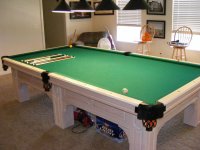10-foot table initially perceived as a "gaff" in the Earl/SVB challenge; not anymore!
Folks:
Without calling anyone out (no need to), it's obvious that the 10-foot table played a HUGE role in the match. Probably more so than many admit, and more likely in the face of the initial pre-match perceptions that the 10-foot table was a "gaff" that would have "minimal impact" on the end result.
While Earl's behavior certainly played a role (there's no doubt about that, even as stoic and seemingly-impervious that Shane is), I'm thinking the 10-foot table played a greater role. I'd warned that I suspected Earl knew what he was doing by introducing the 10-foot table as a constraint in the match, and it appears to have definitely affected the results.
Personally, I'd like to see the "Big Berthas" make a comeback. Perhaps not so much in tournaments (which strive to find the best-playing player on current equipment), but rather for challenge matches -- precisely for the purposes of what the 10-footer represents: an even greater test of pocketing accuracy and cue ball control. The better playing player -- which often translates to "the player that has the better fundamentals and adapts the quickest" -- is sure to be the one left standing.
In years gone by, 10-footers used to be common fare here in the straight pool Northeast. I think Ralph Greenleaf still holds the 14.1 high run record on a 10-footer: 272 (see the eighth paragraph down in this article).
What think ye?
-Sean
Folks:
Without calling anyone out (no need to), it's obvious that the 10-foot table played a HUGE role in the match. Probably more so than many admit, and more likely in the face of the initial pre-match perceptions that the 10-foot table was a "gaff" that would have "minimal impact" on the end result.
While Earl's behavior certainly played a role (there's no doubt about that, even as stoic and seemingly-impervious that Shane is), I'm thinking the 10-foot table played a greater role. I'd warned that I suspected Earl knew what he was doing by introducing the 10-foot table as a constraint in the match, and it appears to have definitely affected the results.
Personally, I'd like to see the "Big Berthas" make a comeback. Perhaps not so much in tournaments (which strive to find the best-playing player on current equipment), but rather for challenge matches -- precisely for the purposes of what the 10-footer represents: an even greater test of pocketing accuracy and cue ball control. The better playing player -- which often translates to "the player that has the better fundamentals and adapts the quickest" -- is sure to be the one left standing.
In years gone by, 10-footers used to be common fare here in the straight pool Northeast. I think Ralph Greenleaf still holds the 14.1 high run record on a 10-footer: 272 (see the eighth paragraph down in this article).
What think ye?
-Sean
